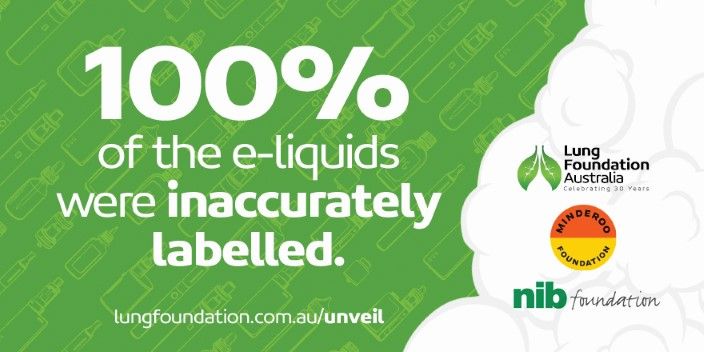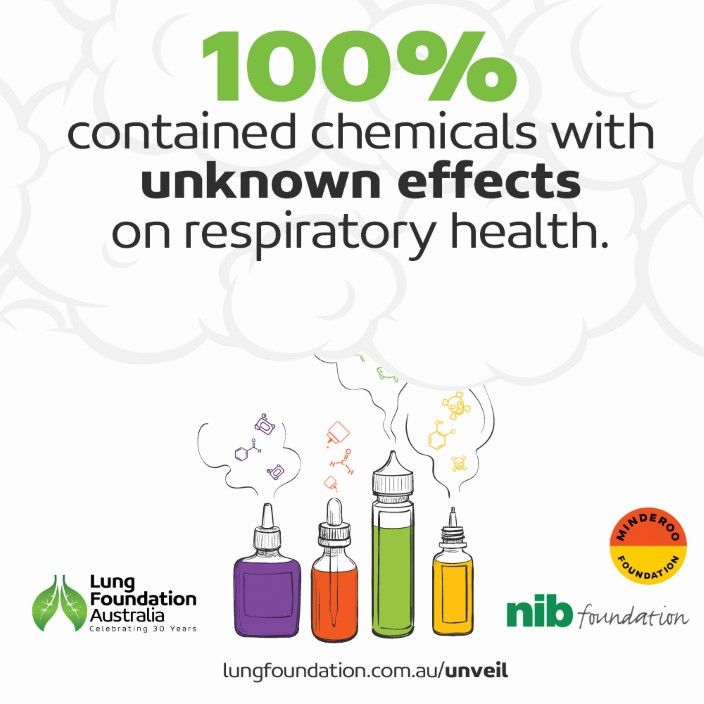The study tested the chemicals and toxicity of 52 flavoured vape e-liquids available for sale over the counter in Australia and found that 100 percent of the products were inaccurately labelled and contained chemicals with unknown effects on respiratory health.
Almost a third of the products also contained chemicals that are likely to be toxic if inhaled repeatedly, while 21 percent contained nicotine, despite the substance being banned in the country.
The chemicals found in these e-liquids were known to cause respiratory disorders, including severe irritation when inhaled, and contribute to the development of lung cancer.
The researchers also found other chemicals safe for use in other consumer and retail products but untested for short- and long-term respiratory health impacts when inhaled.
“With the unregulated, untested, and unknown nature of the vape industry, we knew the research into the chemicals and toxicity of e-liquids would uncover strong findings, but we never expected such alarming results,” Lung Foundation Australia CEO Mark Brooke said.
“Along with the concerning risks to lung health and the inclusion of nicotine, the ingredients within many of these e-liquids include those that are commonly used in household disinfectant, petroleum, cosmetics, paint and even eugenol which is commonly used to euthanise fish,” Brooke said.
“While these may be safe to use for these specific purposes, they haven’t been tested or determined to be safe as an inhalant.”
Brooke said that a nationwide ban was vital to protect Australians, particularly young people, from the known and unknown risks of vaping.
Youth vaping on the rise
“The inclusion of fruit, alcohol, and confectionary flavours, along with deceitful marketing, has meant these products are purposefully positioned as appealing to our younger generation, including school-age children, and in turn, most detrimental to their futures,” Brooke said.
“The damage caused by the continual use of these products could be costing a generation their freedom to healthy lungs and have our hospital respiratory units facing patients with respiratory issues and even lung disease or cancer.”
Uncovering the real dangers
Dr Sukhwinder Sohal, a clinical respiratory scientist who has extensively researched the impact of e-cigarettes, said many users might not realise that any combination of fluid can be placed into these devices, whether stipulated by the manufacturers or not, which meant users were often unaware that they might be inhaling harmful chemicals.
“This is most concerning in young vape users who, by naively experimenting with a combination of inhalants, could end up with ongoing respiratory distress and long-term lung damage,” he said.
Fact sheet
The Lung Foundation has produced a fact sheet for teachers and support staff on vaping. It recommends teachers and support staff be patient, avoid criticism and be open and honest when confronting young people about vaping.
There should be an emphasis on easy discussion and mutual receptivity in a safe, caring and understanding space. Stick with the facts, steer clear of overreaction and keep the emotion out of it, it said.
A good method is to assist young people to make their own informed decisions around the issue. Emphasise the way in which the tobacco industry covertly manipulates them through glossy imagery and savvy marketing. If nicotine addiction is involved, work with them in an open and honest healing space and build rapport to start getting them the help they need.
Above all, always deal with the facts, be sure to underline the health issues and demonstrate authentic care in a non-judgmental setting.
Information campaign
Lung Foundation Australia has also launched an education campaign to raise awareness on the effects of vapes and e-cigs on respiratory health.
The Unveil What You Inhale campaign offers educational resources to support young people, parents, caregivers, teachers, and educators in empowering young people to make informed decisions about their health.
“With the current climate shedding little to no light on these concerns, young vape users are left in the dark about the potential dangers,” Brooke said. “In launching this campaign, we are hoping to change this by arming users, parents, and schools with the resources they need to have those difficult but very important and potentially life-saving conversations.
“That is why we are calling on the country’s teachersand school leaders to take opportunities to have those difficult, but very important and potentially lifesaving, conversations, and share our latest resources that shed light on the concerning risks to lung health, as well as inclusion of nicotine and dangerous chemicals within many of the country’s vape e-liquids to support young vape users in their decision making.”
Lung Foundation resources: bit.ly/3kZTwRd




































































































































